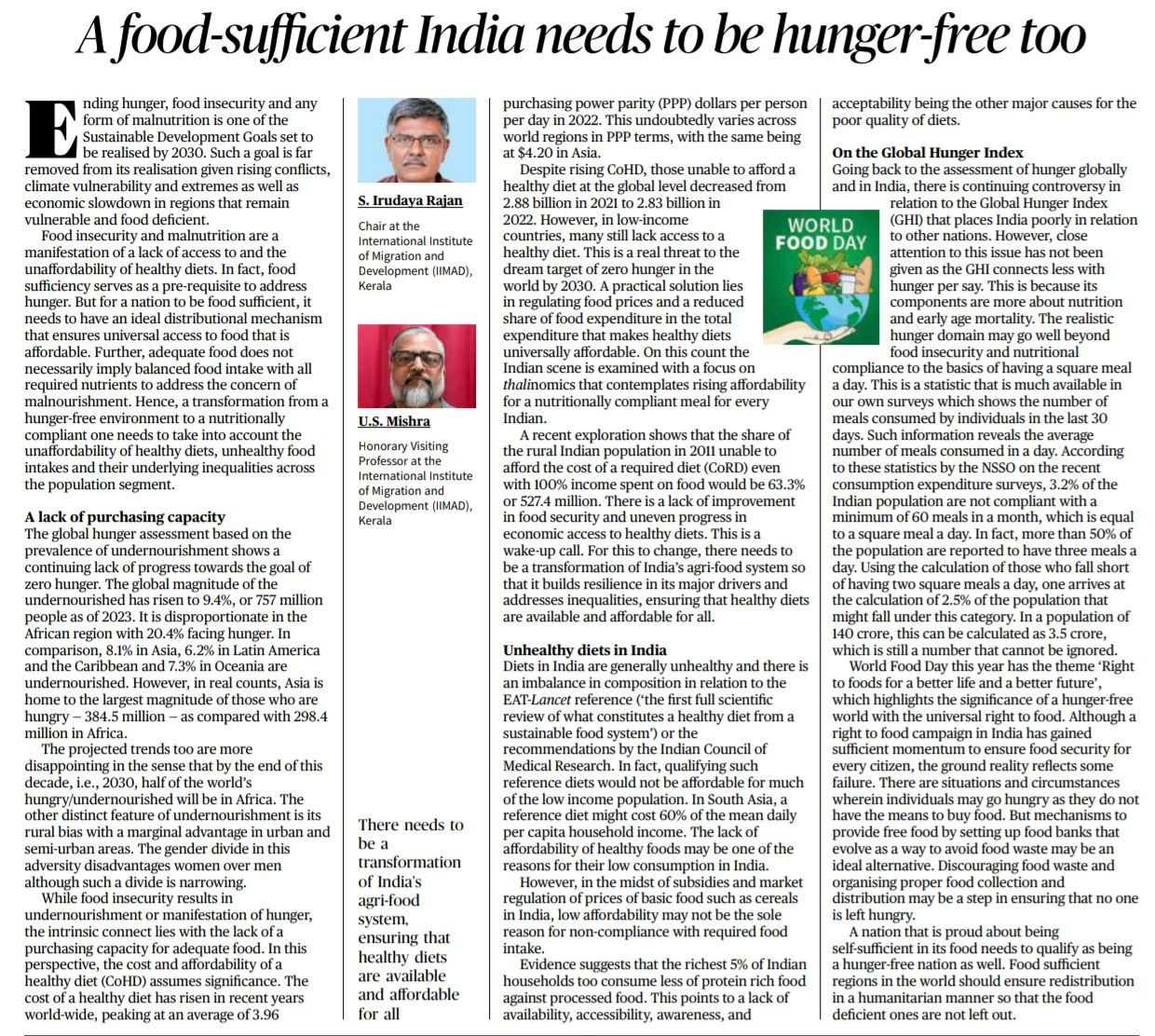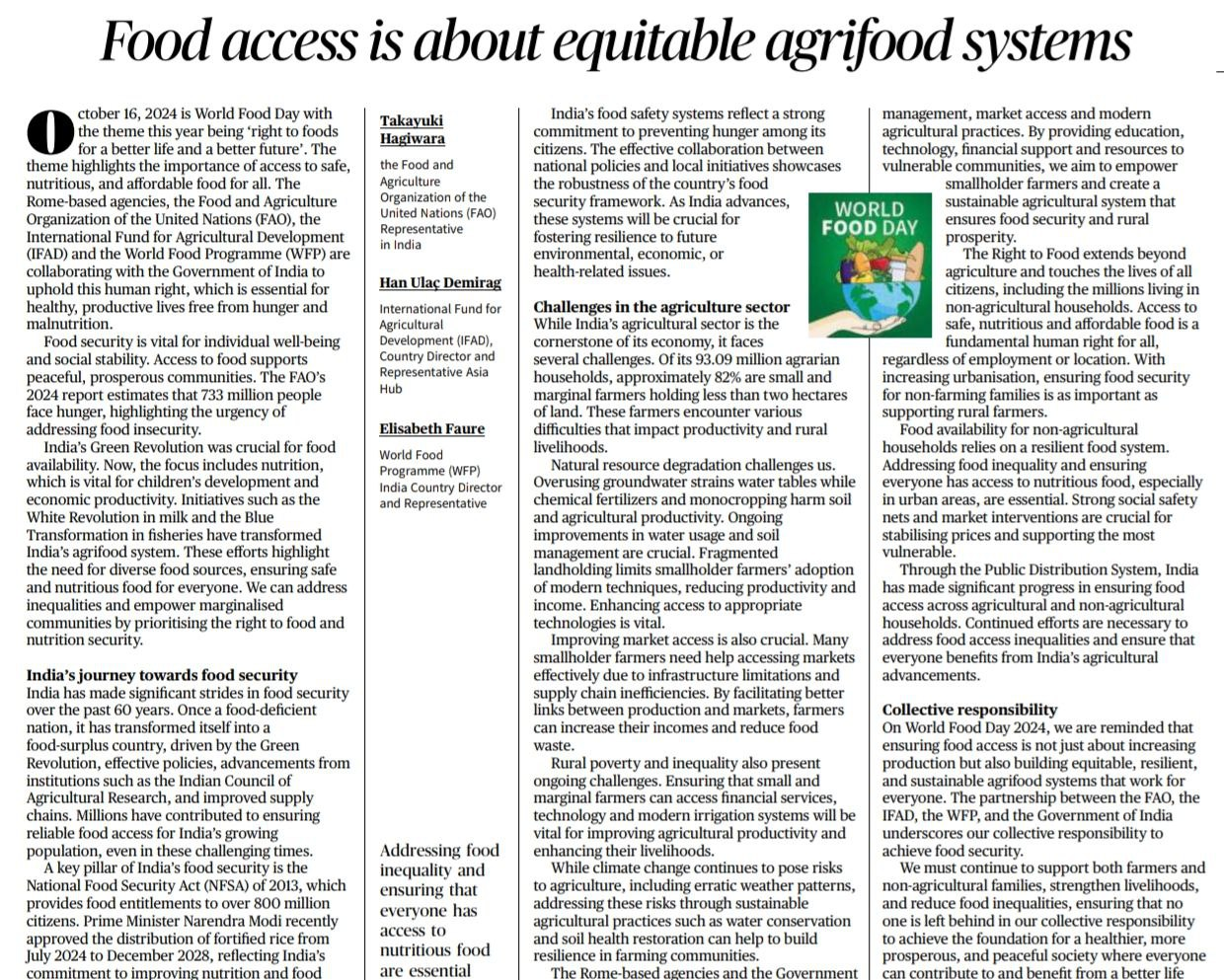1. Moving Beyond Food Sufficiency: Tackling Hunger and Malnutrition in India
Introduction: India has made significant strides in achieving food sufficiency, but food insecurity and malnutrition remain pressing issues.
Achieving Sustainable Development Goal (SDG) 2, which calls for ending hunger by 2030, seems challenging due to rising conflicts, climate vulnerability, and economic disparities.
Addressing hunger is not merely about ensuring food availability but also about tackling the issues of accessibility, affordability, and malnutrition.
- Food Insecurity and Malnutrition:
- Food insecurity and malnutrition stem from the lack of access to nutritious and affordable food. While India has become food-sufficient, it lacks an effective distribution system ensuring universal access to affordable food.
- Addressing hunger requires more than food availability; there must be a focus on healthy, affordable diets that meet nutritional requirements for all, especially the most vulnerable.
- Global Hunger Assessment:
- The Global Hunger Index (GHI) shows a disproportionate undernourished population, especially in Africa, followed by Asia.
- India has the second-largest population of undernourished people, with 9.4% of its population suffering from hunger in 2023. The rural population’s access to food remains significantly low, with a major share unable to afford the minimum caloric requirement.
- Inequalities in Diets and Food Security:
- Indian diets are becoming increasingly unhealthy, with an imbalance in protein intake. The EAT-Lancet reference report shows a deviation from the healthy diet, contributing to undernutrition.
- The proportion of rural Indian households unable to afford the required diet increased to 63.3% in 2011. This reflects a growing economic divide, limiting access to healthy food.
- Challenges with Affordability and Access:
- Healthy diets are cost-prohibitive for many, exacerbating food insecurity. The global cost of a healthy diet is rising, with the Asian average being $4.20/day in purchasing power parity.
- There is a lack of improvement in food security, uneven economic access to healthy food, and unhealthy food choices, causing malnutrition.
- Unhealthy Diets in India:
- Indian diets lack protein, contributing to malnutrition and unhealthy eating habits.
- Regulatory focus is needed on food pricing and reducing expenditure on unhealthy foods while promoting affordable healthy diets.
- Global Hunger Index and Indian Context:
- Despite criticism of the GHI, it reflects the underlying problem of food insecurity in India. Lack of dietary diversity, the consumption of unhealthy foods, and low protein intake point to the systemic challenges in addressing hunger.
- There is also a need for strong nutritional guidelines and policies that ensure food access for every citizen, including vulnerable populations.
Conclusion: India must move beyond just ensuring food availability to achieving food security that includes nutrition, affordability, and sustainability.
A transformation of the agricultural and food system is required to make healthy diets accessible to all, addressing the root causes of hunger and malnutrition in the country.
Without addressing these issues, the dream of ending hunger by 2030 will remain elusive.
Mains Practice Question:
|
Q. What are the key challenges India faces in addressing hunger and malnutrition despite being food-sufficient? Suggest measures to ensure healthy and affordable diets for all citizens in light of these challenges. |
2. Ensuring Food Security Through Equitable Agrifood Systems
Introduction:
- October 16, 2024, marks World Food Day with the theme “Right to Food: Better Life, Better Future”.
- It emphasizes access to safe, nutritious, and affordable food for all, aligning with the Food and Agriculture Organization (FAO), International Fund for Agricultural Development (IFAD), and World Food Programme (WFP).
- Ensuring food security is essential for both well-being and social stability, highlighting the urgency of addressing hunger and malnutrition.
- India’s Journey Towards Food Security:
- India has made significant strides in food security over the past 60 years.
- From a food-deficit nation to a food-surplus country through initiatives like the Green Revolution and White Revolution (milk production).
- The National Food Security Act (NFSA) of 2013 guarantees food provisions for 800 million citizens.
- Emphasis on nutrition along with food availability, particularly focusing on marginalized communities and children’s development.
- Challenges in India’s Agriculture Sector:
- India’s agrarian economy is critical, with 82% of farmers being small and marginal, holding less than 2 hectares of land.
- Natural resource degradation and soil fertility challenges due to overusing groundwater, and monocropping.
- There is a need for sustainable agriculture to mitigate challenges like fragmented landholding and inefficiency in supply chains.
- Addressing inequality in access to nutritious food, especially in urban areas, and enhancing food safety nets and market interventions is crucial.
- Right to Food and Addressing Inequality:
- The Right to Food is a fundamental human right, crucial for ensuring food security for all, regardless of employment or location.
- Non-farming families should have access to nutritious food.
- Ensuring smallholder farmers have the necessary education, technology, and financial support to build a sustainable agrifood system.
- India’s Food Safety and Distribution System:
- Significant progress has been made through the Public Distribution System (PDS) in addressing agricultural and non-agricultural household food access.
- Continued reforms are needed to reduce food access inequalities.
- Collective Responsibility and Global Commitment:
- FAO, IFAD, WFP, and the Indian Government emphasize collective responsibility in addressing food access.
- Focus on creating equitable, sustainable agrifood systems and supporting smallholder farmers is key to achieving food security for all.
Conclusion:
- World Food Day 2024 reminds us that food access is not just about availability but ensuring equitable, resilient, and sustainable agrifood systems.
- India’s journey toward food security is commendable, yet challenges remain in ensuring nutritious food for all.
- Continued efforts in policy-making, farmer support, and infrastructure development will further secure India’s position in global food security.
UPSC Mains Practice Question: |
Q: “Discuss the role of equitable agrifood systems in ensuring food security in India. What are the major challenges in India’s agricultural sector, and how can they be addressed to reduce food inequality?”
|



